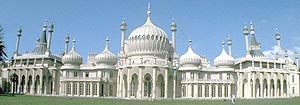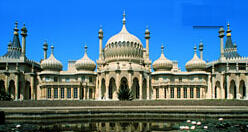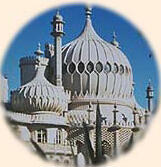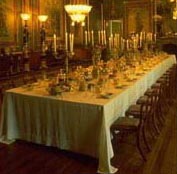
 Brighton Pavilion
Brighton Pavilion

The Royal Pavilion
The palace of George IV
What do a Norfolk turnip, the dome of St. Paul's
Cathedral, a chessboard and the Kremlin have in common?
ANSWER
They are just four ways in which, over the years, people
have tried to describe the Royal Pavilion. I say 'tried' because
King George IV's former seaside residence literally
defies all description.
I say 'tried' because
King George IV's former seaside residence literally
defies all description.
To call it Brighton's answer to
the Taj Mahal simply isn't enough. With its riot of onion
domes and minarets, its blend of refined Indian
architecture and opulent Chinese interiors, the palace is
nothing short of exotic.
It is hard to
believe that this oriental wonderland was born from the
imagination of a man who had never ventured further east
than Germany. In 1783, the dashing young heir to the
throne, George Prince of Wales, paid his first visit to
the thriving resort of Brighthelmstone. It was to be a
visit from which the town never recovered. With more
showmanship than Phineas T Barnum, Brighton's patron
saint - or some say patron sinner - set about creating
his ideal home. 
Over 30 years later, and some �500,000 poorer, George could finally step back and admire the handiwork of his favourite architect, John Nash. Not everybody was as enthusiastic as His Royal Highness. John Wilson Croker, a noted diarist of the day, had this to say: "It is, I think, an absurd waste of money, and will be a ruin in half a century or more".
How
wrong can you get! If the Pavilion can survive a
devastating arson attack, extensive hurrican damage and
let's not forget Queen Victoria who removed everything
including the kitchen sink, then what's to stop the most
extraordinary palace in Europe from celebrating its 200th
birthday in the year 2023? 
Such a show of resistance against the ravages of time may have something to do with the dragons that feature in every corner of the Pavilion and who, in Chinese mythology, symbolize good fortune. But be prepared to encounter much more than a galaxy of weird and wonderful creatures. Retrace the illustrious footsteps of Rossini who performed amid the razzle-dazzle of the Music Room or Lord Byron who made merry in the lavish Banqueting Room. Recently restored to its full 19th century grandeur the palace's astonishing colour schemes and superb craftsmanship will amaze you.
 Return to the Fridge door
Return to the Fridge door